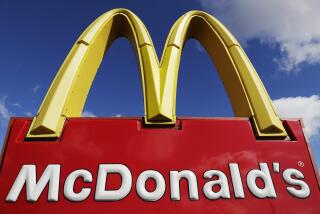Staying in the Game With More Dollar Offerings
- Share via
Struggling with weak sales last December, 99 Cents Only Stores offered an explanation: no eggs or butter.
The retailer had to temporarily stop carrying the two staples when wholesale prices jumped. Tagging either at more than a penny less than a buck was out of the question. The company hasn’t done that with any item since 1982, “when we opened our first store,” said President Eric Schiffer. And the strategy has paid off: Schiffer said that none of 99 Cents Only’s outlets -- 150 in California and 45 in other states -- had ever failed to turn a profit.
The dollar-store industry has fared handsomely in recent years by selling on the cheap, if not always for a dollar. With 16,000 stores nationwide and annual sales of $16 billion, the chains in the no-frills niche make up retail’s fastest-growing segment, according to Todd Hale, senior vice president of consumer insights for AC Nielsen.
Dollar stores historically have catered to lower-income shoppers, but some are stretching to attract new customers by offering jazzier housewares, more brand names, dairy products and even gourmet items. And in a study of shoppers who patronized dollar stores at least once a year from 2000 to 2003, AC Nielsen found the highest growth rate was among households with annual incomes of $70,000 and above.
The 99 Cents Only Store on Wilshire Boulevard -- two miles from Rodeo Drive -- is the company’s best performer, Schiffer said, with sales of more than $10 million last year, compared with $4.9 million for an average company store.
Katherine Hunter, a magazine publisher from Beverly Hills, has been a regular at the Wilshire store for eight years. It’s “addicting,” the 54-year-old said. “You pay 99 cents here and you go to the market and pay $2.39,” she continued, pointing to a package of Sunsweet pitted prunes. “How can you not?”
Over the last three years, as many other retailers saw growth slow and moved to trim square footage, the five largest dollar-store companies as a group expanded their store count by 44%.
The Commerce-based 99 Cents Only chain is pushing into Texas, Arizona and Nevada with plans to boost square footage by 25% this year. Goodlettsville, Tenn.-based Dollar General Corp. -- the industry leader with 6,800 stores -- plans to open almost 700 more in 2004. And Family Dollar Stores Inc., based in Matthews, N.C., will open at least 525 new stores. (Both Dollar General and Family Dollar are considered “dollar store” chains even though they sell some products that cost well more than a buck.)
Neither Dollar General nor Family Dollar has stores in California, but that will probably change. “You’re going to have an invasion,” said John Zolidis, with Buckingham Research Group.
Collectively, the top dollar-store retailers saw overall sales climb 18% from 1997 through 2002, said David Yamamoto, an analyst with WR Hambrecht & Co. By comparison, U.S. retail sales in that period, excluding autos, grew 5%.
Most dollar-store companies’ shares have gained as well. In the last year, Dollar General’s stock rose 49%; Family Dollar Stores’ shares are up 14%; and the stock of Chesapeake, Va.-based Dollar Tree Inc., which has about 160 stores in California, swelled 43%.
As for 99 Cents Only, its shares lost 6% of their value in the last year. After three years of steady profit gains, 99 Cents Only saw net income fall 4% in 2003 as it incurred costs related to its push into Texas, where competition is particularly fierce. Sales rose 18% to $846 million.
Much of the merchandise in dollar stores is basic -- from paper goods to cleaning supplies -- and a special-purchase item can spark a buying frenzy, such as the 200 Levi jackets priced at $1 each that nearly sold out in one day at Dollar Tree in Chino last Tuesday.
These days, dollar stores face new hurdles as competition intensifies and other retailers, including mass merchants, grocers and convenience stores, aim to respond to consumers’ insatiable appetite for low prices.
Wal-Mart Stores Inc. has experimented by altering the way it displays goods in 20 stores, clustering products priced at $1 or lower in “Pennies-N-Cents” sections. Not to be outdone, Target Corp. in January launched its own in-store test at some locations called “The One Spot,” arranging together items priced at $1 or less, including clothes, toys and baby goods.
The increasing competition so worried Fredric E. Russell Investment Management Co. that it unloaded all of its shares of Dollar General and Family Dollar last year. “If Wal-Mart ever decides they ... can bring their vast financial prowess and their knowledge into the dollar industry, it could be very, very interesting,” said Fredric Russell, owner of the Tulsa, Okla., firm.
So dollar stores are searching for fresh ways to spark sales, toying with new products or dabbling in higher-priced goods, or both.
Family Dollar offers “ethnic food products,” including items targeting Latino shoppers, spokeswoman Sandra Wilkenloh said. It also sells $25 comforter sets that include dust ruffles and shams, as well as “bedding and bath ensembles” in palm prints, complete with matching lamps and candlesticks.
At 99 Cents Only Stores, the response was a “gourmet fancy food section,” complete with shiitake mushrooms, olive oil and hearts of palm, launched 18 months ago. The stores also sell wine -- “all corked,” Schiffer was quick to note -- and cellphone accessories and, in its bridal sections, champagne glasses and baskets with fake flower petals.
But its prices are set in stone, Schiffer said. The company would sooner rejigger the packaging than ask more than 99 cents by, for example, selling an eight-pack of eggs instead of a dozen.
The chain pays an average 60 cents per item wholesale. To help keep margins steady, analysts say, companies in this niche buy products in large volume or odd sizes, as well as acquiring close-out or “special-situation” merchandise. In the case of dairy products, Schiffer said, supermarkets may demand longer shelf lives than 99 Cents Only will accept.
Regular shoppers have learned to watch package dates closely. Among the products 82-year-old Adele Malamud selected during a recent visit to the Wilshire store was a container of cream cheese with asparagus that was stamped with a “best before” date of the following day.
Malamud, who doesn’t drive, is such a fan that she hires a cab to ferry her there about twice a month. “I love coming here, I do,” said the Los Angeles retiree, who spends a couple of hours selecting her purchases before the taxi returns to retrieve her. “Sometimes the bargains are wonderful.”
At midday, the store was bustling, with aisles crowded and six of eight check-out lanes open, all of them busy. Debora Ragan said she warmed to the fixed-price concept during the recent grocery clerks strike when she began shopping at the 99 Cents Only more frequently. By the time the strike ended, she was hooked.
“For meat I still go to the market, but for other essentials, I find myself coming back here,” said the 47-year-old stay-at-home mom, whose cart was piled with Jello pudding snacks, cheddar crackers, frozen waffles and toaster strudel. “Sometimes I can spend up to $50. But that’s 50 items.”
More to Read
Inside the business of entertainment
The Wide Shot brings you news, analysis and insights on everything from streaming wars to production — and what it all means for the future.
You may occasionally receive promotional content from the Los Angeles Times.










